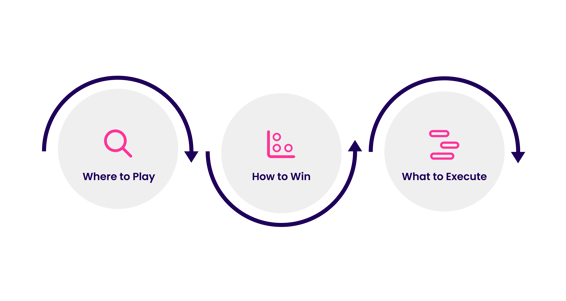Innovation has the power to transform any organization. The innovation manager’s role, therefore, comes with an equally high level of fascination and expectation—which can be intimidating, especially for newcomers.
They say the first 100 days (or approx. 3 months) in a new position define your make-or-break time. During this period, innovation professionals need to establish a solid foundation for future innovation activities, build strong relationships with multiple stakeholders, and develop a pioneering vision. So, what can you do differently in those - or any other - 100 days to get things on track?
Based on our experience in innovation, foresight, and strategy with hundreds of industry leaders, we've identified 12 building blocks that help you to become the innovation manager every company is dreaming of. No matter how experienced you are, we’ve got you covered.
Get Your ultimate Toolkit to become a true Innovation Rockstar in <100 Days
The Three Innovation Maturity Levels
Depending on the stage of your innovation career you are currently at, you are most likely pursuing different goals and needs. We distinguish between three levels of innovation maturity, each with a different focus:
Innovation Rookie
Innovation Rookies have just embarked on their innovation journey. They are eager to understand and internalize the essence of innovation. By grasping the role of innovation in shaping our society, economy, and environment and adopting an Innovation Rockstar mindset, they become capable of turning theory into practice.
You are a Rookie? Start from the beginning and make sure you are clear on the fundamentals.
Innovation Rebel
Innovation Rebels take the first steps towards change. They question the current status quo in their organization and seek to proactively lead innovation activities towards success. By following best practices, they learn how to build the capabilities and use the tools to create the necessary breeding ground for innovation.
The interesting part for Innovation Rebels starts from building block #4.
Innovation Rockstar
Innovation Rockstars have all it takes to be well-prepared for the future. They pursue a pioneering vision of how to create a competitive advantage and transform their market. Their organization and culture have embedded innovation in their DNA and spur innovation activities with sufficient resources and dedicated innovation roles and processes.
If you consider yourself already an expert in your field, jump to building block #9 and learn what matters to become an even better innovation manager than you already are.
Our Innovation Rockstar Toolkit guides you through 12 building blocks to move from Rookie to a killer Innovation Rockstar by providing valuable tools, resources, and best practices.
The Building Blocks for Successful Innovation Management
We have identified 12 key topics that we believe must be considered for successful innovation management. Starting with the real basics around innovation, which most of you would probably call "general knowledge", up to essential core tasks within the innovation process. The last four building blocks are designed for true innovation pioneers who want to gain a competitive advantage and transform their company and the market in the long run.
1. Understand the Innovation 101
First of all, you should know about the basics of innovation and its role in shaping our world. This starts with being aware of important innovation terminology and establishing the right mindset. Moreover, you need to understand the core concepts in innovation management such as how to build an innovation ecosystem or which internal and external sources of innovation to use.
Relevant tools: Innovation Glossary, Innovation Ecosystem Map, Innovation Posters
2. Strive for Disruptive Innovation
Disruptive innovation is the type of innovation that most companies strive for. It leads to new technologies, products, concepts, or business models that drive change. These innovations challenge industry leaders who have not innovated quickly enough to adapt to the shift in the needs of their target audiences. As a result, existing models are disrupted and entire industries are transformed. To become a disruptor yourself, you need to identify what markets, technologies, and business models are driving your company and how you can combine these to create new, game-changing ventures.
Relevant tools: 4 States of Disruption, Table of Strategic Elements
3. Foster Corporate Innovation
As startups increasingly outperform their corporate counterparts, it is imperative for established companies to embrace corporate innovation. To approach innovation in a corporate context you need to identify a strategy on how to embark on your innovation journey within the organization. Inspiration could be Cisco’s 5 pillars of corporate innovation. Furthermore, you need to build a strong innovation community consisting of internal and external experts who support your innovation activities.
Relevant tools: Cisco’s 5 Pillars of Innovation, Innovation Community Map
4. Establish an End2End Innovation Process
To emerge as a winner in the battle for attractive future markets, you need to be able to channel the flood of information on the market and transform it into new products and business models. But innovation is much more than ideation and out-of-the-box ideas. An end2end innovation process should provide answers to these three strategic questions: “Where to Play?”, “How to Win?”, and “What to Execute?”. Having the entire process mapped on a digital platform helps to bring all relevant stakeholders together and collaboratively work on innovation activities.
Relevant tools: Innovation Big Picture, Digital Innovation Management Platform
5. Identify “Where to Play” Through Environmental Scanning
Before you jump into generating new ideas for future products, services, and business models, you first need to identify forces that are shaping your business environments. These include drivers of change, trends, emerging technologies, and startups. You also need to be able to evaluate their relevance for your business and the impact they have on the market in the short and long term to uncover the most relevant, impactful, and transformative areas in which to play.
Relevant tools: Industry Trends & Technologies, Trend & Tech Radars
6. Get From Trends to Opportunity Spaces
Beneficial innovation opportunities can be discovered by reaping the rewards from your environmental scanning activities. Connect the dots between diverse pieces of information that you may already know (such as market trends, emerging technologies, and your business model), and put them together in a new way that breaks a pattern. An opportunity is a potentially rewarding business situation in which your organization can create significant benefits by addressing previously unmet customer needs uniquely and/or introducing new, better solutions to existing customer needs.
Relevant tools: Opportunity Space Canvas, ITONICS Insights
7. Understand “How to Win” With Ideation & Innovation Portfolios
In the “How to Win” stage of the innovation process, ideas are brought into play. Strategic fields of innovation identified in “Where to Play'' can be directed towards targeted idea development and management. This means that you generate ideas for the opportunity spaces identified before and then generate an evaluated innovation portfolio. In this context, a balanced portfolio between core, adjacent, and transformational innovation should also be taken into account.
Relevant tools: 70:20:10 Rule of Innovation, ITONICS Campaigns, ITONICS Portfolio
8. Be Clear About “What to Execute” With Roadmaps
Roadmapping is a method for strategic long-term planning, implementation, and visualization of innovations, products, and technologies—broken down to the necessary resources, steps, and milestones and aligned with the corporate strategy. It pushes your business from the status quo to a desired future visionary state and forms the last step in the end2end innovation journey.
Relevant tools: ITONICS Roadmap
9. Develop Pictures of the Future with Scenario Analysis & Planning
Scenario planning and scenario impact analyses are tools for strategic foresight and are used by true Innovation Rockstars. They help key decision-makers, innovation leads, and strategists to create projections about what the world around us will look like in the future and make strategic decisions based on that information.
Relevant tools: Trend Radars, Scenario Space Matrix, Scenario Impact Roadmapping
10. Communicate Innovation Activities & Gain Management Commitment
Another essential building block of successful innovation management is effective communication within the organization and achieving commitment from the management. Intentional communication and dissemination of information in appropriate ways increase the visibility and transparency of innovation activities and invite the participation of all stakeholders in achieving innovation goals.
Relevant tools: Innovation Growth Boards
11. Drive Sustainability Through Innovation
Innovation and sustainability go hand in hand. Anyone who deals with innovation must also consider the impact it has on society and the environment. 2020 kicked off the Decade of Action — 10 years to meet the goals outlined in the UN 2030 Agenda for Sustainable Development and mitigate the impact of climate change. The need for innovations that support a sustainable future has never been higher.
Relevant tools: Sustainability Trend Report, Sustainability Trend & Technology Radars
12. Promote Competitive Advantage With an Innovation Framework
Clarity, structure, and blueprints for innovation functions are scarce goods. Innovation frameworks can help set the focus and serve to systematically develop new competencies in an organization and monitor progress in key competency areas. ITONICS COFIM (Control Objectives for Innovation Management) is a framework that has been designed based on 10+ years of experience and constructive collaboration. It defines the innovation capabilities that need to be present in successful corporate innovation systems.
Relevant tools: Innovation Framework (COFIM), Innovation Maturity Assessment
Our toolkit “From Innovation Rookie to Rockstar” guides you through the above-mentioned 12 building blocks with 60+ practical insights including all relevant tools, tips, and best practices from other innovative companies.
Get the complete guide and become the innovation manager every company is dreaming of!











